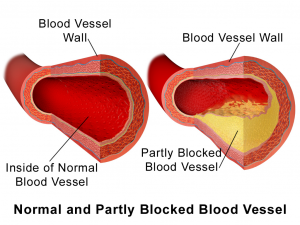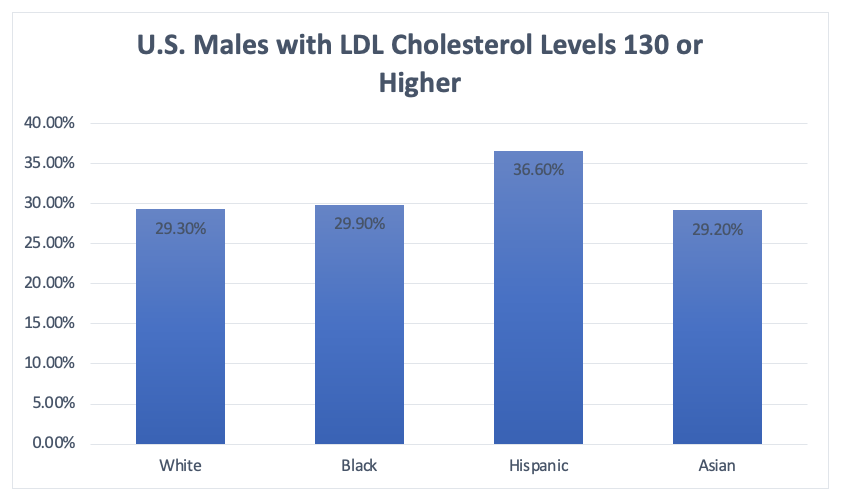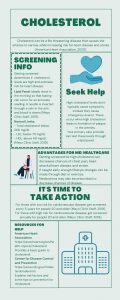Rebecca Corallo
What is Cholesterol?
When most people think about cholesterol, they generally assume that it is only harmful for the body. While too much cholesterol can cause negative effects, it is still needed for the body to function properly. Cholesterol is a waxy substance that is produced by the liver and it is also consumed through animal products, such as meat and dairy. It is important because it helps cells grow, while also making vitamins and hormones (American Heart Association, 2020).
Types of Cholesterol
The two main types of cholesterol include low-density lipoprotein (LDL) and high-density lipoprotein (HDL). LDL is considered “bad” cholesterol because it can cause a buildup of plaque in the arteries, which is known as atherosclerosis. The more the arteries narrow, the higher the risk is for a heart attack, stroke, and peripheral artery disease. HDL on the other hand is considered “good” cholesterol. It is able to carry about ¼ of the LDL cholesterol through the bloodstream back to the liver where it is broken down (American Heart Association, 2020). By doing this, HDL is able to decrease the risk for heart disease and stroke.

Risk Factors
Risk factors can greatly increase the chances of having high cholesterol levels, including some health conditions, lifestyle, and family history. While an individual is unable to change their genetics, age, or race, there are certain lifestyle modifications that can be made. Both type 2 diabetes and obesity increase the chances for high cholesterol by lowering HDL and raising LDL levels. Some lifestyle habits that increase risk of high cholesterol are eating a diet high in saturated fats and trans-fat, low amounts of physical activity, and smoking. Smoking damages the arteries, causing them to have a higher buildup of plaque (Centers for Disease Control and Prevention [CDC], 2020).
Genetics and Cholesterol
High cholesterol can run in families, which is known as familial hypercholesterolemia. It is a genetic condition that raises LDL cholesterol levels and if not diagnosed early enough, it can worsen with age. There is currently a prevalence rate of 1 in 200 people, with that number increasing more and more each year (Bouhairie & Goldberg, 2015). It is important that if a child has a family member with elevated cholesterol levels, then they should be screened for familial hypercholesterolemia beginning at age 9-11.
Age, Gender, and Ethnicity Effect on Cholesterol
Age, gender, and ethnicity can also play an important role in cholesterol levels. For both males and females, cholesterol levels naturally increase with age. This is because as the body ages, it is no longer able to clear as much of its LDL cholesterol from the bloodstream. Females typically have lower LDL cholesterol until around age 55 as this is normally when menopause occurs. During menopause, the amount of the hormone estrogen begins to drop. The decrease in estrogen levels is associated with an increase in total cholesterol levels as well as an increase in LDL cholesterol (Harvard Health Publishing Harvard Medical School, 2020). Also, at any age, men have lower HDL cholesterol levels than women.
Ethnicity should also be taken into account when looking at cholesterol levels. Hispanic males typically have higher cholesterol levels, with 36.6% of Hispanic males living in the United States having LDL cholesterol levels of 130 or higher (American Heart Association News, 2019). This can be compared to the ethnicity with the lowest LDL cholesterol levels of 29.2% for Asian males and non-Hispanic Black males and non-Hispanic White males in the middle with LDL cholesterol levels of 29.9% and 29.3% respectively (American Heart Association News, 2019). These values can be summarized in Chart 1. It is also important to note that a healthy LDL cholesterol level is considered to be 100 mg/dL or lower.
Chart 1

Diagnosing Cholesterol
Diagnosing high cholesterol levels is typically done through a blood test known as a lipid panel or lipid profile. This test will show the results for total cholesterol, LDL cholesterol, HDL cholesterol, and triglycerides (a type of fat that is found in the blood). In the United States, cholesterol levels are measured in milligrams (mg) of cholesterol per deciliter (dL) of blood. When interpreting results for total cholesterol levels, the desired amount is 200 mg/dL or below and high is 240 mg/dL and above, seen in Table 1 (Mayo Foundation for Medical Education and Research, 2019). The levels for LDL cholesterol are dependent on whether or not there is a presence of heart disease already (Table 2). For HDL cholesterol, 60 mg/dL and above is considered the best and below 40 mg/dL is poor as seen in Table 3 (Mayo Foundation for Medical Education and Research, 2019). If there is no or low risk for heart disease, then individuals should be checked around age 20 and again every 5 years (Mayo Foundation for Medical Education and Research, 2019). Those that do have risk factors for high cholesterol levels are recommended to get their levels checked more frequently.
Table 1: Total Cholesterol
| Below 200 mg/dL | Desirable |
| Above 240 mg/dL | High |
Created based on data from: Mayo Clinic Staff. (2019, July 13). High cholesterol. https://www.mayoclinic.org/diseases-conditions/high-blood-cholesterol/diagnosis-treatment/drc-20350806.
Table 2: LDL Cholesterol
| Below 70 mg/dL | Best for people that have heart disease or diabetes |
| Below 100 mg/dL | Best for people at risk for heart disease |
| 100-129 mg/dL | Best if there is no heart disease. High if there is heart disease. |
| 130-159 mg/dL | Borderline high if there is no heart disease. High if there is heart disease |
| Above 160 mg/dL | High if there is no heart disease. Very high if there is heart disease |
Created based on data from Mayo Foundation for Medical Education and Research. (2019, July 13). High cholesterol. https://www.mayoclinic.org/diseases-conditions/high-blood-cholesterol/diagnosis-treatment/drc-20350806.
Table 3: HDL Cholesterol
| Below 40 mg/dL (men) | Poor |
| 40-59 mg/dL (men) | Optimal |
| Above 60 mg/dL | Best |
Created based on data from Mayo Foundation for Medical Education and Research. (2019, July 13). High cholesterol. https://www.mayoclinic.org/diseases-conditions/high-blood-cholesterol/diagnosis-treatment/drc-20350806.
Lifestyle Changes That Reduce High Cholesterol
Although most people might believe that the only way to reduce one’s cholesterol level is through the use of medications, it has been found that a high fiber diet or more plant-based diet and exercise can greatly reduce the high numbers. There are two different types of fiber, soluble and insoluble fiber. Soluble fiber works by creating a thick gel in the intestines (Tello, 2019). This slows digestion and prevents fats from being absorbed. Foods that are high in soluble fiber include oatmeal, beans, and fruit. Insoluble fiber can be found in whole grains and vegetables and helps to keep stools soft and regular (Tello, 2019). It is currently recommended that 20 to 35 grams of fiber should be consumed daily with 5 to 10 of those grams coming from soluble fiber (Harvard Health Publishing Harvard Medical School, 2019).

Nuts, vegetable oils, and soy can also be beneficial as they work by directly lowering the amount of LDL cholesterol by up to 5-6% (Harvard Health Publishing Harvard Medical School, 2019). Studies have shown that foods rich in plant sterols and stanols can lower cholesterol levels by blocking the body from directly absorbing the cholesterol (Harvard Health Publishing Harvard Medical School, 2019). Many food companies are currently adding them into a variety of foods ranging from granola bars to chocolate, and they can also be consumed through supplements. Lastly, eating fish a couple of times a week can lower LDL cholesterol by providing omega-3s (Harvard Health Publishing Harvard Medical School, 2019). These reduce the amount of fat in the bloodstream and also protect the heart from heart disease (Harvard Health Publishing Harvard Medical School, 2019). If planning a new diet in order to lower cholesterol, be sure to include plenty of fruits and vegetables, whole grains, protein that mainly comes from plants.
Not only can food have an impact on an individual’s cholesterol levels, but physical activity does as well. By increasing the amount of regular exercise, the amount of HDL cholesterol increases while maintaining the amount of LDL cholesterol and triglycerides (Mann et al., 2013). Although all exercise is beneficial, it has been found that strength training increases HDL cholesterol levels more than increasing the intensity of a workout. In fact, a high-intensity workout is no more effective at increasing the amount of HDL cholesterol than a moderately intense exercise (Mann et al., 2013).
Medications That Reduce High Cholesterol
While maintaining a healthy lifestyle through getting the proper nutrients and regularly exercising is a good first defense against high cholesterol, it isn’t always enough. An individual’s doctor might recommend that cholesterol medications be taken in order to reduce the high levels. Medications can do one of three things: decrease LDL cholesterol, decrease triglycerides, or increase HDL cholesterol (Mayo Clinic Staff, 2021). There are several different classes of medications, with one of the most common being statins. These work by decreasing the amount of both LDL cholesterol and triglycerides, while also slightly increasing HDL cholesterol. Another class, known as the cholesterol absorption inhibitor, works the same way. For those that have high cholesterol running in their family, the drug class PCSK9 inhibitor is commonly used (Mayo Clinic Staff, 2021). The protein, PCSK9, is found in the liver, with high amounts of it causing high cholesterol levels (Heart United Kingdom, 2018). It is common for families with high cholesterol levels to pass down the genes that cause high PCSK9 levels (Heart United Kingdom, 2018). By inhibiting PCSK9, LDL cholesterol levels decrease as well as total cholesterol levels. It is also important to note that side effects are possible with these medications and to always speak with a healthcare provider if symptoms continue or worsen.
Conclusion
Overall, cholesterol is important for the body to function, however too much can have bad effects and eventually lead to heart disease and or stroke. There are many risk factors for high cholesterol, some of which can be prevented while others cannot. It is important to consume a heart-healthy diet, exercise regularly, and get cholesterol levels checked every 4-6 years. Since there are a lot of treatment options, it is best to speak with a healthcare provider in order to figure out what works best for each individual.

Chapter Review Questions
1. Which type of cholesterol can help prevent heart disease?
A. HDL Cholesterol
B. LDL Cholesterol
C. Triglycerides
D. Lipoprotein(a) Cholesterol
2. If a child has a family history of high cholesterol levels, at what age should they start getting screened?
A. 3-5 years old
B. 9-11 years old
C. 12-14 years old
D. 15-18 years old
3. What is the current recommendation for daily fiber intake?
A. 5-10 grams
B. 40-50 grams
C. 50-70 grams
D. 20-35 grams
References
American Heart Association. (2020, November 6). What is cholesterol? https://www.heart.org/en/health-topics/cholesterol/about-cholesterol
American Heart Association News. (2019, January 11). Ethnicity a ‘risk-enhancing’ factor under new cholesterol guidelines. https://www.heart.org/en/news/2019/01/11/ethnicity-a-risk-enhancing-factor-under-new-cholesterol-guidelines
Bouhairie, V. E., & Goldberg, A. C. (2015). Familial hypercholesterolemia. Cardiology Clinics, 33(2), 169-179. 10.1016/j.ccl.2015.01.001
Centers for Disease Control and Prevention. (2020, September 08). High cholesterol facts. https://www.cdc.gov/cholesterol/facts.htm
Harvard Health Publishing Harvard Medical School. (2020, May). Take control of rising cholesterol at menopause. https://www.health.harvard.edu/womens-health/take-control-of-rising-cholesterol-at-menopause
Harvard Health Publishing Harvard Medical School. (2019, February 6). 11 foods that lower cholesterol. https://www.health.harvard.edu/heart-health/11-foods-that-lower-cholesterol.
Heart United Kingdom. (2018, June 21). PCSK9 inhibitors cholesterol treatment & any side effects. https://www.heartuk.org.uk/getting-treatment/pcsk9-inhibitors#:~:text=The%20PCSK9%20protein%20breaks%20down,less%20cholesterol%20in%20the%20blood.
Mann, S., Mann, S., Beedie, C., Beedie, C., Jimenez, A., & Jimenez, A. (2013). Differential effects of aerobic exercise, resistance training and combined exercise modalities on cholesterol and the lipid profile: Review, synthesis and recommendations. Sports Medicine (Auckland), 44(2), 211-221. 10.1007/s40279-013-0110-5
Mayo Clinic Staff. (2021, February 2). Cholesterol medications: Consider the options. Mayo clinic. https://www.mayoclinic.org/diseases-conditions/high-blood-cholesterol/in-depth/cholesterol-medications/art-20050958
Mayo Foundation for Medical Education and Research. (2019, July 13). High cholesterol. Mayo clinic. https://www.mayoclinic.org/diseases-conditions/high-blood-cholesterol/diagnosis-treatment/drc-20350806.
Tello, M. (2019, June 24). Fiber-full eating for better health and lower cholesterol. Harvard health publishing harvard medical school. https://www.health.harvard.edu/blog/fiber-full-eating-for-better-health-and-lower-cholesterol-2019062416819
a solid chemical element that is used especially in wood preservatives, alloys, and semiconductors and is extremely toxic in both pure and combined forms
any of several minerals (such as chrysotile) that readily separate into long flexible fibers, that have been implicated as causes of certain cancers, and that have been used especially formerly as fireproof insulating materials
a substance or agent causing cancer
treatment or prevention of disease (such as an autoimmune disorder, allergy, or cancer) that involves the stimulation, enhancement, suppression, or desensitization of the immune system
A syndemic involves several separate but connected health problems that have come together to interact with one another
A mental illness diagnosed by a mental health professional that greatly disturbs your thinking, moods, and/or behavior and seriously increases your risk of disability, pain, death, or loss of freedom.

